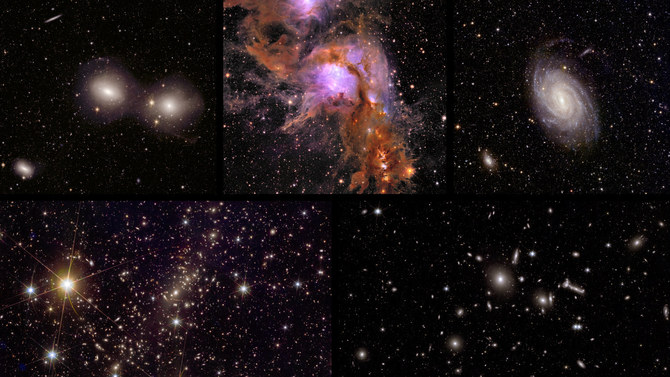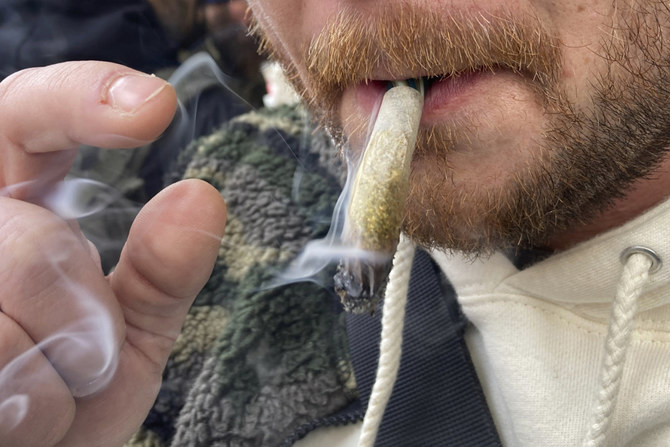Forever-young Minnie Mouse is growing up and moving on from her old red and white polka dots.
Lanvin has designed the loveable Disney rodent a new dress — a more mature frock in royal blue and long sleeves that she can wear at special Paris events.
It was unveiled at a catwalk show in Disneyland Paris on Saturday evening.
Gone was the oversized hair bow that has been the signature of the character since she was created in 1928. In its place, the catwalk presentation showcased a smaller-sized red tiara alongside a thick, bejeweled hourglass gown with padded shoulders.
“Walt Disney was the one that actually designed Minnie. It’s the first time an actual designer has come into the picture and designed a dress for her,” Lanvin’s designer Alber Elbaz told The Associated Press following the show.
“It was a great challenge and responsibility to do. I just wanted her to shine... I wanted to give her a crown in red, and the dress in blue, (a signature) for Lanvin.”
The dress got applause from the celebrity-filled front row including actress Virginie Ledoyen and model Natalia Vodianova.
But the more mature look — which also did away with her famed white bloomers — didn’t impress everyone.
“It’s definitely more mature. It looks a bit mother of the bride,” said spectator Matthew Gallagher. “I preferred the polka dots.”
Traditionalists will be pleased to know that Disney says Minnie will be allowed to keep her red and white look for normal events.
Minnie has also kept her full hourglass figure. Last October, images destined for Barneys New York shop window were criticized after Minnie became a long, lean high-fashion model. Dubbed “skinny Minnie” the short film featured the mouse-fatale in a hot-pink, ruffle covered Lanvin dress — with longer legs, leaner arms and daintier gloved hands.
“We’re not here to transform people,” said Elbaz. “We love her the way she is.”
Grown-up Minnie Mouse gets mature Lanvin makeover
Grown-up Minnie Mouse gets mature Lanvin makeover

Kodi, star of ‘Dog on Trial,’ takes home Cannes’ top dog prize

- The Griffon mix was praised for his “breathtaking” performance as Cosmos, a guide dog for a visually impaired man
- Xin, the greyhound who made a star turn in Chinese director Guan Hu’s “Black Dog,” was awarded the Palm Dog’s Grand Jury Prize
CANNES, France: There was lots of tail-wagging and face-licking as Kodi, this year’s winner of the Palm Dog, the canine equivalent of the Cannes Film Festival’s top prize, went up to receive his red collar for the French comedy “Dog on Trial” on Friday.
The Griffon mix was praised for his “breathtaking” performance as Cosmos, a guide dog for a visually impaired man, who goes on trial over an attack, in a case whose outcome could mean death.
“This film is very significant because it not only explores the bond between humans and dogs but it takes a satirical, comedic but quite profound look at the way that we domesticate dogs and the way that we relate to dogs, and the way our justice system relates to dogs,” said critic and jury member Anna Smith.
Xin, the greyhound who made a star turn in Chinese director Guan Hu’s “Black Dog,” was awarded the Palm Dog’s Grand Jury Prize.
Xin was in Cannes to don the red collar for the film about an ex-convict tasked with ridding his town of stray dogs who befriends one of them.
The unofficial awards show, which was created in 2001, is now in its 24th edition.
Kodi succeeds last year’s winner, Messi from Justine Triet’s “Anatomy of a Fall,” who converted his star power into a French TV show in which he, through the voice of French humorist Raphael Mezrahi, interviews people at this year’s festival.
Other past winners include Brandy, a pit bull belonging to Brad Pitt’s character in “Once Upon a Time in Hollywood” and Tilda Swinton’s spaniels, who co-starred with her in a film directed by Joanna Hogg.
Massive cradle of baby stars revealed in new space telescope images

- The European Space Agency released the photos from the Euclid observatory on Thursday
- Euclid will spend the next several years observing billions of galaxies covering more than one-third of the sky
CAPE CANAVERAL, Florida: A massive cradle of baby stars has been observed in new detail by a European space telescope, adding to its celestial collection of images.
The European Space Agency released the photos from the Euclid observatory on Thursday.
They were taken following the telescope’s Florida launch last year as a warm-up act to its main job currently underway: surveying the so-called dark universe.
From its perch 1 million miles (1.6 million kilometers) from Earth, Euclid will spend the next several years observing billions of galaxies covering more than one-third of the sky.
The shape and size of all these galaxies can help scientists understand the mysterious dark energy and dark matter that make up most of the universe.
“Euclid is at the very beginning of its exciting journey to map the structure of the universe,” the space agency’s director general, Josef Aschbacher, said in a statement.
Among the newly released pictures is one of an enormous cradle of baby stars some 1,300 light-years away known as Messier 78. A light-year is 5.8 trillion miles. Euclid’s infrared camera peered through the dust enveloping the stellar nursery, revealing new regions of star formation, according to ESA.
Daily marijuana use outpaces daily drinking in the US, a new study says

- In 2022, an estimated 17.7 million people reported using marijuana daily or near-daily compared to 14.7 million daily or near-daily drinkers,
- The number of daily users suggests that more people are at risk for developing problematic cannabis use or addiction, says researcher
For the first time, the number of Americans who use marijuana just about every day has surpassed the number who drink that often, a shift some 40 years in the making as recreational pot use became more mainstream and legal in nearly half of US states.
In 2022, an estimated 17.7 million people reported using marijuana daily or near-daily compared to 14.7 million daily or near-daily drinkers, according an analysis of national survey data. In 1992, when daily pot use hit a low point, less than 1 million people said they used marijuana nearly every day.
Alcohol is still more widely used, but 2022 was the first time this intensive level of marijuana use overtook daily and near-daily drinking, said the study’s author, Jonathan Caulkins, a cannabis policy researcher at Carnegie Mellon University.
“A good 40 percent of current cannabis users are using it daily or near daily, a pattern that is more associated with tobacco use than typical alcohol use,” Caulkins said.

The research, based on data from the National Survey on Drug Use and Health, was published Wednesday in the journal Addiction. The survey is a highly regarded source of self-reported estimates of tobacco, alcohol and drug use in the United States.
From 1992 to 2022, the per capita rate of reporting daily or near-daily marijuana use increased 15-fold. Caulkins acknowledged in the study that people may be more willing to report marijuana use as public acceptance grows, which could boost the increase.
Most states now allow medical or recreational marijuana, though it remains illegal at the federal level. In November, Florida voters will decide on a constitutional amendment allowing recreational cannabis, and the federal government is moving to reclassify marijuana as a less dangerous drug.
Research shows that high-frequency users are more likely to become addicted to marijuana, said Dr. David A. Gorelick, a psychiatry professor at the University of Maryland School of Medicine, who was not involved in the study.
The number of daily users suggests that more people are at risk for developing problematic cannabis use or addiction, Gorelick said.
“High frequency use also increases the risk of developing cannabis-associated psychosis,” a severe condition where a person loses touch with reality, he said.
Russian court fines man for hair dyed in colors of Ukrainian flag, OVD-Info says

- Photographs of Stanislav Netesov posted online show the 25-year-old’s close-cropped hair colored bright blue, green and yellow
- Netesov was found guilty of discrediting the armed forces on May 3, an online court notice shows, although it does not specify a fine
LONDON: A Russian man who had his hair dyed in some of the colors of the Ukrainian flag has been fined 30,000 roubles ($330) by a court for “discrediting” the Russian army, rights group OVD-Info reported on Monday.
Photographs of Stanislav Netesov posted online show the 25-year-old’s close-cropped hair colored bright blue, green and yellow. Blue and yellow are the colors of the Ukrainian flag.
More than 20,000 people have been detained for their anti-war stance since the start of Moscow’s full-scale invasion of Ukraine in February 2022, with over 900 people charged with criminal offenses.
Netesov was found guilty of discrediting the armed forces on May 3, an online court notice shows, although it does not specify a fine.
In court, Netesov denied his hair color was meant as a statement of protest, saying that he does not support either Ukraine or the Russian army, independent news outlet Mediazona reported. He said he has dyed his hair bright colors for years.
Netesov could not be reached for comment.
The case against the Muscovite began in late April, when he was attacked by unknown people while returning home from work late at night.
The assailants stole his mobile phone and knocked out one of his teeth, Netesov told OVD-Info, which assists those targeted for opposing the war.
When he went to the police to file a report, officers noticed his hair and charged him under the “discrediting” statute, Mediazona reported.
“The aforementioned visual propaganda clearly expressed a negative attitude toward the Armed Forces of the Russian Federation,” Mediazona cited the police report as saying.
Officers also gave Netesov a summons to report to a military enlistment office. He then revealed to them he was a transgender man, after which they canceled the summons, Mediazona said.
Swarmed with tourists, Japan town blocks off viral view of Mt. Fuji

- The mass of visitors and their refusal to obey rules on littering and parking had become a nuisance and traffic hazard
FUJIKAWAGUCHIKO, Japan: Japan’s majestic Mt. Fuji was some 700,000 years in the making, but on one sultry May morning, it was gone.
At least on one side of a busy road, views of the 3,776-meter (12,388 foot) symbol of Japan and the Lawson convenience store beneath it have vanished, as officials finished a 20-meter by 2.5-meter barrier to obstruct a photo spot that had become viral among tourists.
For locals, the mass of visitors and their refusal to obey rules on littering and parking had become a nuisance and traffic hazard.
“I’m really happy that foreigners are coming to our town,” said Kikue Katsumata, 73, a lifelong resident of Fujikawaguchiko. “But when it comes to taking pictures from the Lawson, the road is a bit narrow and it can be dangerous when people dash across without using a crosswalk.”
March and April set all-time records for visitor arrivals, driven by pent-up demand after the pandemic and as the yen’s slide to a 34-year low made Japan an irresistible bargain. That’s been good news for the economy, with travelers spending a record 1.75 trillion yen ($11.2 billion) in the first three months of 2024, according to the tourist agency.
The drastic decision to block the view of Mt. Fuji symbolizes tensions across the country as Japan reckons with the consequences of its tourism boom. The western metropolis of Osaka and the hot spring resort town Hakone are among municipalities considering new tourism taxes to deal with deluge of visitors.
Cyril Malchand, a 45-year old visitor from France, found out about the fence online and made a special trip to be among the last to take in the view. He said he empathized with the locals.
“When I see that there could be problems with people crossing the road without watching cars, I don’t find it that bad that they’re setting up that fence,” he said.


















